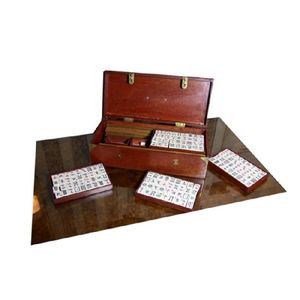Victorian Joseph Rodgers Cutlery Set in Oak Canteen
You must be a subscriber, and be logged in to view price and dealer details.
Subscribe Now to view actual auction price for this item
When you subscribe, you have the option of setting the currency in which to display prices to $Au, $US, $NZ or Stg.
- Victorian Period - The Victorian period of furniture and decorative arts design covers the reign of Queen Victoria from 1837 to 1901. There was not one dominant style of furniture in the Victorian period. Designers used and modified many historical styles such as Gothic, Tudor, Elizabethan, English Rococo, Neoclassical and others, although use of some styles, such as English Rococo and Gothic tended to dominate the furniture manufacture of the period.
The Victorian period was preceded by the Regency and William IV periods, and followed by the Edwardian period, named for Edward VII (1841 ? 1910) who was King of the United Kingdom and the British Dominions and Emperor of India for the brief period from 1901 until his death in 1910. - Britannia Metal / Epbm - Britannia metal items, often marked as "EPBM", are composed of a pewter type alloy of tin animony and copper, First produced in 1769, Britannia metal can be temporarily polished to a silver-like lustre. When electroplate was introduced in the mid 19th century, the Britannia newly manufactured Britannia metal items were oftern silver plated, but the plating wears off relatively quickly leaving an unappealing grey surface.
Britannia metal should not to be confused with Britannia standard silver, which is a higher grade of silver than sterling silver, containing at least 958 parts per thousand of pure silver, - Gadrooning - A series of lobes usually as a border. In furniture gadrooning is found as carved decoration around the edges of table tops in the Chippendale and Jacobean style furniture. Gadrooning is also found as decoration on the rims of silver and ceramics.
- Fiddleback - A name given to the pattern of the grain in some timbers, where the lines of the grain are compressed and at the same time wavy. Fiddleback grain is prized as a timber for furniture and musical instruments, and is expensive becasue of its scarcity.
In Australia fiddleback graining is found in blackwood. Other non-native timbers that are sometimes found with a fiddleback grain are mahogany and maple. - Harlequin Set - A "harlequin set" or "matched set" of chairs, is a set in which the chairs are similar, but not identical in design and construction, as in a true set. At a time when complete sets of chairs are increasingly difficult to find, dealers often have to rely on assembling a matched set from various sources. The world 'Harlequin' derives from the Italian comedy figure who traditionally wears a diamond-patterned costume. It is sometimes used to describe a pattern of inlay in this design.
- Oak - Native to Europe and England, oak has been used for joinery, furniture and building since the beginning of the medieval civilisation. It is a pale yellow in colour when freshly cut and darkens with age to a mid brown colour.
Oak as a furniture timber was superceded by walnut in the 17th century, and in the 18th century by mahogany,
Semi-fossilised bog oak is black in colour, and is found in peat bogs where the trees have fallen and been preserved from decay by the bog. It is used for jewellery and small carved trinkets.
Pollard oak is taken from an oak that has been regularly pollarded, that is the upper branches have been removed at the top of the trunk, result that new branches would appear, and over time the top would become ball-like. . When harvested and sawn, the timber displays a continuous surface of knotty circles. The timber was scarce and expensive and was used in more expensive pieces of furniture in the Regency and Victorian periods. - Epbm / Britannia Metal - Britannia metal is a pewter type alloy, that can be temporarily polished to a silver-like lustre. In the 19th century, Britannia metal, was often electroplated. Plated wares in this metal may be marked EPBM (electro-plated Britannia metal). Where the silver plate wears on an EPBM item, the surface colour is dull grey, similar to pewter. Britannia metal was generally used as a cheaper alternative to electroplated nickel silver (EPNS) which is more durable. The primary component of nickel silver is copper and wear on an EPNS item will be indicated by a copper colored hue in the wear spots. EPBM items are held in low regard by collectors.
This item has been included into following indexes:
- helmets - military pickelhaube helmet 155
-
tables, purpose or type
- coffee, pre 1950 91
- tea, other 87
Visually similar items

A twelve place silver plate cutlery canteen with ivorine handles, Harrison Bros & Howson. In a fitted mahogany case. One carving fork missing, circa 1930.

Early and well constructed carpenters/joiners tool box with removable sliding shelves, full top the top with tools including Sorby and Marples chisels, steel calipers, saws, plane part, etc, everything marked with carpenter's name F. Hartley

Mahjong set bone mounted pieces contained in a brass bound fitted box.

A silver canteen. Maker Harrison & Howson, Sheffield 1951. Jacobean silver table. 11dinner forks and 12 entree forks, 12 entree knives, 12 dinner knives, 8 jam spoons, 12 teaspoons, carving set, 2 sugar tongs, 2 gravy spoons, soup ladle, sauce ladle, 12 so
